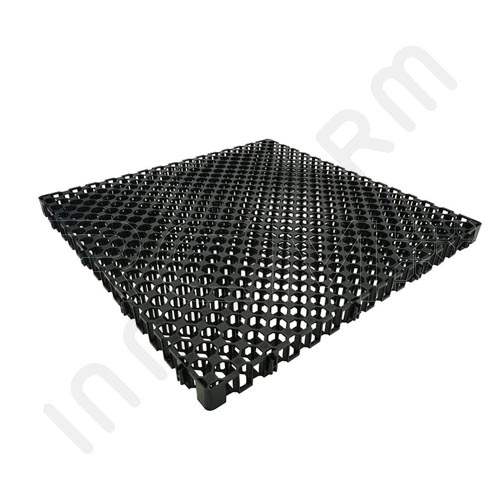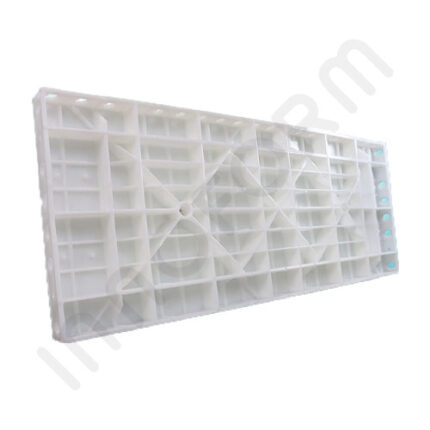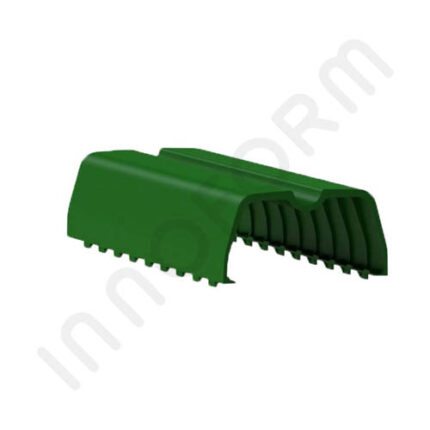Drainage Cells
Effective water management is crucial in various construction and landscaping projects to ensure long-term durability and prevent structural damage. One key component used to address water management challenges is the drainage cell, a lightweight, high-strength material that facilitates water drainage while offering structural support. Drainage cells are widely applied in green roofs, retaining walls, and landscaping to prevent water buildup, manage stormwater, and protect waterproofing layers.
In the Middle East, where rapid urbanization and large-scale development projects are on the rise, Innoform has emerged as a leading producer of drainage cells. By manufacturing high-quality, durable products designed for the region’s unique environmental conditions, Innoform is helping to enhance water management systems in construction projects across the region. This article explores the design, functionality, benefits, and applications of drainage cells, with a focus on Innoform’s role in providing these essential materials in the Middle East.
What is a Drainage Cell?
A drainage cell is a modular, geosynthetic product designed to create an efficient drainage layer beneath surfaces. It is typically made of high-density polyethylene (HDPE) or polypropylene, ensuring durability, chemical resistance, and the ability to withstand significant loads. The cells have an open, grid-like structure that allows water to flow freely while maintaining a stable foundation for structures built above them.
Drainage cells are often used in conjunction with filter fabric and waterproofing membranes to direct water away from structures and into designated drainage outlets. Their design prevents the buildup of hydrostatic pressure, which can damage waterproofing systems or lead to structural issues. The cells are usually easy to install, lightweight, and customizable to fit a variety of applications, from flat surfaces to sloped terrain.
Design and Functionality
The unique design of drainage cells allows them to perform multiple functions in a water management system:
- Water Drainage
The primary function of drainage cells is to facilitate the movement of water away from critical areas. Their open-cell structure creates channels for water to flow freely, reducing the risk of waterlogging and preventing damage to structures caused by prolonged water exposure. - Load Distribution
While drainage cells are lightweight, they are designed to support heavy loads. When placed under green roofs, pavements, or other surfaces, they provide structural support while ensuring that water is drained efficiently. This makes them ideal for areas that require both drainage and load-bearing capacity. - Prevention of Hydrostatic Pressure
Hydrostatic pressure builds up when water accumulates against a structure, such as a retaining wall or the foundation of a building. Drainage cells help relieve this pressure by providing an escape route for the water, protecting the structure from long-term damage. - Protection of Waterproofing Layers
In applications where a waterproofing membrane is used, such as in green roofs or podium decks, drainage cells act as a protective barrier. They prevent soil, roots, or debris from puncturing the membrane, ensuring its integrity over time. - Thermal Insulation
In some applications, such as green roofs, drainage cells can contribute to thermal insulation by creating an air gap between the surface and the underlying structure. This helps regulate temperature and reduces the heat load on buildings.
Benefits of Drainage Cells
Drainage cells offer a range of benefits, making them a preferred choice in various construction and landscaping applications:
- Efficient Water Management
Drainage cells ensure that water is drained effectively from surfaces, reducing the risk of waterlogging, erosion, or structural damage. This is particularly important in areas with high rainfall or where water must be managed carefully to prevent flooding. - Versatility
Drainage cells can be used in a variety of settings, including green roofs, retaining walls, landscaped areas, podium decks, and even sports fields. Their modular design allows them to be tailored to different project requirements. - Lightweight and Easy to Install
The lightweight nature of drainage cells makes them easy to transport and install, reducing labor costs and time. Their interlocking design allows for quick assembly, whether they are being installed on a flat surface or a slope. - Durability and Resistance
Made from materials such as HDPE or polypropylene, drainage cells are resistant to chemicals, UV rays, and biological degradation. This ensures that they maintain their functionality over a long lifespan, even in harsh environmental conditions. - Cost-Effective Solution
By preventing water-related damage and reducing the need for extensive drainage systems, drainage cells offer a cost-effective solution for water management in construction projects. They also help reduce maintenance costs over time by protecting waterproofing layers and reducing the risk of structural damage.
Key information about drainage cells:
| Aspect | Description |
|---|---|
| Definition | A modular geosynthetic product used to manage water drainage in construction and landscaping projects. |
| Material | Typically made of high-density polyethylene (HDPE) or polypropylene for durability and resistance to degradation. |
| Primary Function | Facilitates water drainage, prevents waterlogging, and protects waterproofing membranes. |
| Key Benefits | – Efficient water drainage – Load distribution – Hydrostatic pressure relief – Easy installation |
| Applications | – Green roofs – Retaining walls – Podium decks – Landscaping – Subsurface drainage |
| Design | Open grid structure that allows water to flow freely while providing structural support. |
| Installation | Lightweight and easy to install with an interlocking design for quick assembly in various settings. |
| Load-Bearing Capacity | Capable of supporting significant loads while allowing efficient water drainage. |
| Durability | Resistant to chemicals, UV rays, and environmental degradation, ensuring a long lifespan. |
| Thermal Insulation | Contributes to thermal insulation in some applications, such as green roofs. |
| Preventing Hydrostatic Pressure | Reduces pressure buildup against structures by providing an escape route for water. |
| Manufacturer in the Middle East | Innoform, a key producer of drainage cells, offering solutions designed for the region’s climate and development needs. |
This table highlights the essential characteristics, benefits, and uses of drainage cells in construction and landscaping projects.
Applications of Drainage Cells
Drainage cells are used in a variety of applications where water management and structural support are critical. Some of the most common uses include:
- Green Roofs
Green roofs are an increasingly popular way to enhance urban sustainability by reducing heat, improving air quality, and providing aesthetic value. Drainage cells play a crucial role in green roofs by ensuring proper drainage of excess water while protecting the waterproofing membrane. They also help create a stable base for the planting medium. - Retaining Walls
Drainage cells are installed behind retaining walls to manage water buildup. Without adequate drainage, water can accumulate behind the wall, increasing pressure and potentially causing the wall to fail. The drainage cells allow water to drain away from the wall, reducing hydrostatic pressure and extending the wall’s lifespan. - Podium Decks
In buildings with podium decks, where outdoor spaces are built over indoor areas, drainage cells help manage water runoff and protect the waterproofing layer. They provide a reliable drainage solution for surfaces exposed to the elements, such as courtyards, terraces, or walkways. - Landscape Areas
Drainage cells are often used in landscaped areas to manage stormwater and prevent waterlogging. They are particularly useful in large-scale landscaping projects, such as parks, golf courses, or sports fields, where proper drainage is essential to maintain the health of the vegetation and the integrity of the surface. - Subsurface Drainage
In some projects, drainage cells are used beneath paving or concrete surfaces to provide subsurface drainage. This helps prevent the buildup of water beneath hard surfaces, reducing the risk of cracking or other damage caused by water pressure.
Innoform: A Leader in Drainage Cell Production in the Middle East
In the Middle East, managing water efficiently is particularly important due to the region’s harsh climatic conditions and the growing demand for urban development. Innoform has positioned itself as a leading producer of drainage cells in the region, providing innovative solutions for water management in construction and landscaping projects.
Innoform’s drainage cells are designed to meet the region’s unique needs, offering a durable and efficient solution for various applications. By using high-quality materials and advanced manufacturing techniques, Innoform ensures that their products are resistant to the challenges posed by the Middle Eastern environment, including extreme temperatures and exposure to UV radiation.
Some of the key features of Innoform’s drainage cells include:
- Durability: Innoform uses materials that are resistant to chemical degradation, UV rays, and extreme weather conditions, ensuring long-lasting performance.
- Customizable Solutions: The modular design of the drainage cells allows for customization to meet the specific needs of each project, whether it’s a green roof, retaining wall, or podium deck.
- Sustainability: Innoform is committed to sustainable construction practices, using eco-friendly materials and processes that reduce environmental impact.
With their expertise and dedication to quality, Innoform continues to play a crucial role in enhancing water management systems across the Middle East.
Conclusion
Drainage cells are an essential component in modern construction and landscaping projects, providing an efficient solution for water management and structural support. Their versatility, durability, and ease of installation make them a valuable tool in a wide range of applications, from green roofs to retaining walls. In the Middle East, Innoform stands out as a leading producer of drainage cells, offering high-quality products designed to meet the region’s specific challenges. As urbanization continues to grow, the importance of effective water management will only increase, and drainage cells will remain a key solution in achieving that goal.







Reviews
There are no reviews yet.